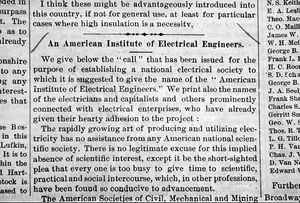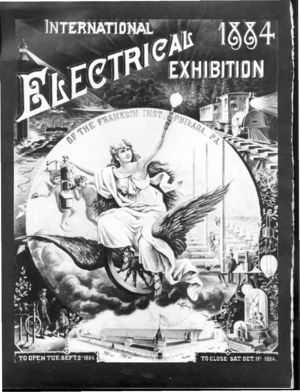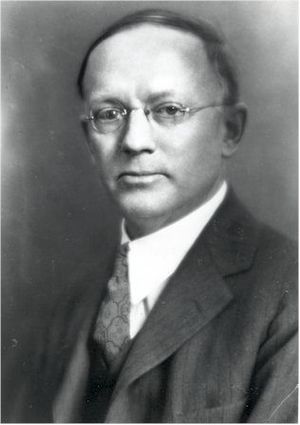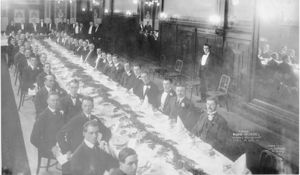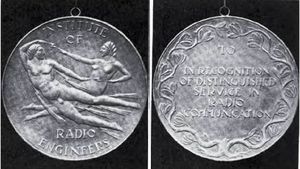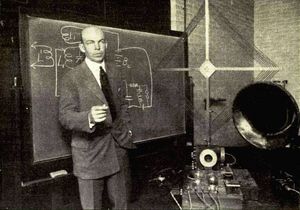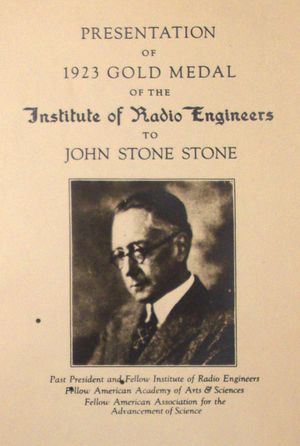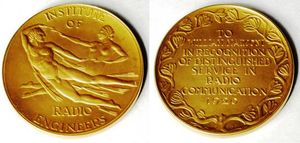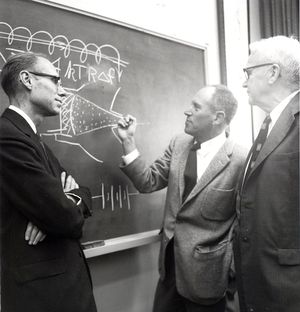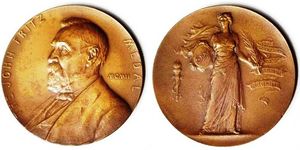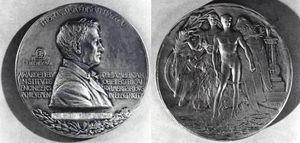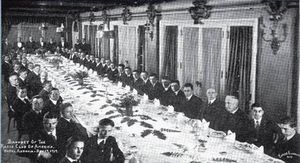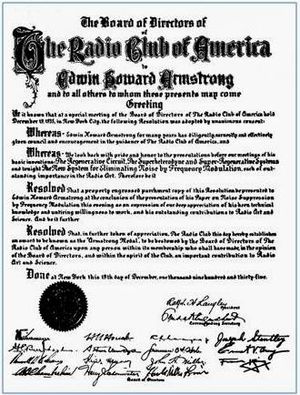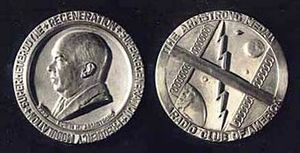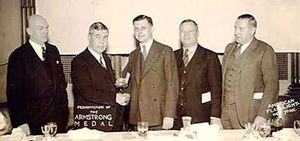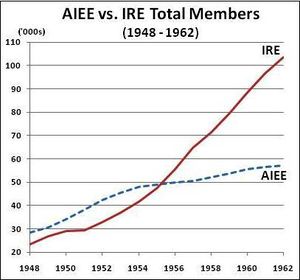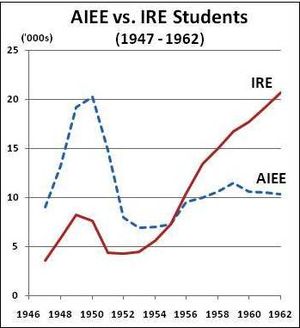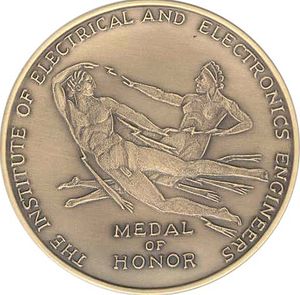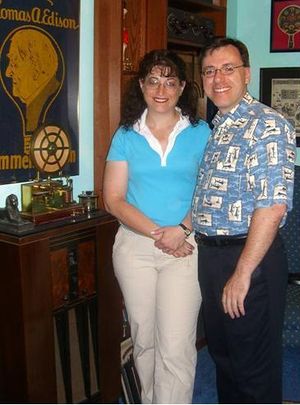IEEE Medal of Honor
Origins of the IEEE Medal of Honor
By David and Julia Bart, 2011
Introduction
The Institute of Electrical and Electronics Engineers (IEEE) is the world’s largest technical society with approximately 400,000 members in 150 countries. The Medal of Honor is the IEEE’s most prestigious award for meritorious accomplishments in the fields of electronics and electrical engineering. Since 1917, the most important contributors to these fields have received the Medal in recognition of their critical roles in laying the foundations of the modern electric world. This article presents the story of the Medal, its origins, connections to other major awards, and its legacy of honor.
The Organizations
First Professional Associations
By the mid-1850s, electricity had made its grand entrance into society. The technology for employing electrical telegraph communications was developing rapidly following the work of Charles Wheatstone and Samuel F.B. Morse. Indeed, this technology was now nearly twenty years old. The joint American and British effort to span the Atlantic with a telegraph cable was currently underway. Clocks coordinated by telegraph were being used to standardize time management and schedule the railroads. Burglar alarms and electric elevators were on the horizon, and new uses for electricity were being developed daily (Century of Electricals, 1984; Ryder & Fink, 1984).
Prior to 1860, most scientific and technical information was disseminated through the publications of learned societies, books and privately published letters, correspondence and pamphlets. The most respected scientific journals were “refereed” by the British Royal Society (Barton, 1998). The rapid growth of telegraphy and new applications of electricity further stimulated demand for sharing more information in an organized and timely manner. Soon, new technical journals emerged to bridge the gap between scientific discoveries and their engineering applications. The Electrician began publication in 1861, and The Telegraphic Journal was published weekly from 1861 to 1899 when it was renamed The Electrical Review.[1] The British telegraph industry was particularly driven by the influence of Sir William Thomson (later known as Lord Kelvin) and its many renowned electrical engineers. They created demand for, and organized, the first professional societies and journals specifically catering to the electrical sciences. With the success of the 1866 Atlantic Cable, most scientific and popular magazines or journals carried articles about submarine telegraphy (Barton, 1998).
Between 1870 and 1890, professional, technical and academic societies were helping to facilitate greater communication and the direct exchange of knowledge and ideas in many fields (Frary, 2008). Thomson worked to establish a dedicated technical society and corresponding journal that catered to the unique interests of telegraphers and electrical engineers. In 1871, he became a founding member and the first vice-president of the new British Society of Telegraph Engineers (BSTE). Thomson regarded the society as a vehicle that would bridge the gap between theory and practice in the electrical sciences by providing a place for organized cooperative discourse on topics of common interest. The BSTE was the first professional society focused specifically on the new science and technology of electricity.[2]
American Institute of Electrical Engineers
The Americans were not far behind their British counterparts.[3] Beginning in the 1860s, new American publications emerged that provided a platform for telegraphers and electrical workers to share information. The National Telegraph Union founded The Telegrapher in 1864. The Operator was founded in 1874, and the Journal of the Telegraph was founded by Western Union in 1877. Unlike their British colleagues, American telegraphers were not heavily involved in the creation of submarine cable telegraph systems. Therefore, they were less interested in creating a “science” of electricity based on the laws of induction. Instead, the Americans were driven by practical experience and a spirit of invention. Nevertheless, American telegraphers increasingly sought a formal means to communicate scientific and technical discoveries. Many Americans were members of the BSTE, but they needed a society of their own. The American Electrical Society was founded in 1875; but it, and a number of smaller societies that followed, did not survive the decade (McMahon, 1984; Israel, 1992).
By 1880, advanced automated technologies were being applied to telegraphy, and the telephone was making inroads into the communication field. The Civil War was a distant memory, and the nation was united by the trans-continental telegraph and the trans-continental railroad. Thomas Edison had installed the world’s first central station for electric power generation in New York City, and electric lighting was beginning its march across the country. The industry’s leading professionals soon made two more attempts to form a national society for electricians; founding the New York Electrical Society in 1881 and the Franklin Institute’s electrical section in 1882. (McMahon, 1976; Israel, 1992).
The International Electrical Exhibition hosted by The Franklin Institute was scheduled to take place in Philadelphia in September, 1884. Nathan S. Keith, an inventor and electrometallurgical engineer, wanted American professionals to form their own organization so that they could participate in the Exhibition on an equal footing with their international peers. Keith, along with Thomas Edison, Elihu Thomson, Edwin Houston, Edward Weston and twenty other prominent leaders in the American electrical sciences, issued three published “calls” to create a national organization. Their calls noted that the Philadelphia Exhibition would be attended by numerous “foreign electrical savants, engineers, and manufacturers” and that “it would be a lasting disgrace to American electricians if no American electrical national society was in existence to receive them with the honors due them from their collaborators in the United States” (McMahon, 1984; Reiman, 1984). Keith organized a formal meeting on May 13, 1884 at the American Society of Civil Engineers (the oldest American professional society founded in 1852) to “unite those involved in the art of producing and utilizing electricity” (Century of Electricals, 1984). The attendees drew up a charter and named themselves the American Institute of Electrical Engineers (AIEE).[4] The first technical session of the newly formed AIEE was held at The Franklin Institute during the ten day Exhibition. By far, the largest numbers of new members were inventor-manufacturers and corporate managers, but electrical engineers, electricians, professors and instructors were well represented. Nine future presidents of the AIEE were among the Exhibition’s eighty-nine American representatives (McMahon, 1976 & 1984).
Over time, the AIEE would deliver a distinguished group of presidents including Alexander Graham Bell, Charles Proteus Steinmetz, Schuyler S. Wheeler, Dugald C. Jackson, Michael I. Pupin and Titus G. LeClair (IEEE Global, 2011f). Although early topics included telegraph and telephone communications, the challenges of electric power generation and the design of electric motors soon dominated the interests of the AIEE. The standardization of electrical units, definitions and nomenclature were also top priorities. Edison’s legendary battle with Nikola Tesla and George Westinghouse regarding alternating versus direct current technologies grabbed headlines and fostered scientific research. Increasingly, communications technology was relegated to a secondary concern of the society (see Note 3).
The First Wireless Associations
The science and technology of wireless telegraphy traces its roots to the experiments of Oliver Lodge and Heinrich Hertz and to Guglielmo Marconi’s development of a working system in the late 19th century. Professional engineers, amateur experimenters and academic scientists raced to claim new inventions and discoveries that would enable the new technology to succeed. But, the technology underlying wireless involved the use of many more scientific and theoretical concepts than land-line telegraphy. Limited practical approaches once used to propel the growth of the telegraph industry were no longer robust enough to meet these new challenges. University trained engineers, academic scientists and advanced amateurs with specialized interests soon dominated early progress in the field. Applications of engineering theory, rather than practical mechanical expertise, were now playing the key role (McMahon, 1984; Israel, 1992). This was seen in the AIEE’s leadership which, by 1900, was dominated by corporate electrical engineers and no longer had manufacturers in leadership positions. Ten years later, over 85% of AIEE’s leadership were directly employed in the electrical industry or were consultants for large companies, and the need for college training was indisputable (McMahon, 1976). Demand for professional associations dedicated to radio and wireless communications could have provided the impetus for change within the AIEE. But, given the AIEE’s focus on electrical power generation, and its lack of emphasis on communications technology, a new association would have to satisfy the growing demand by professionals for a society that was relevant to their interests. Even at a time when companies were intensely competitive and protective of their technological secrets, professionals still needed a place to share ideas and to learn from one another (Proceedings, 1952; Whittemore, 1957). In 1912, the Institute of Radio Engineers (IRE) became the premier professional organization satisfying this demand. Its roots lie in the consolidation of two smaller predecessor organizations, the Society of Wireless Telegraph Engineers (SWTE) and The Wireless Institute (TWI).[5]
SWTE was founded in Boston on February 25, 1907 by John Stone Stone[6] and eleven members of the engineering staff of Stone Wireless Telegraph Company and its successor the Stone Telegraph & Telephone Company (collectively, “STTC”).[7] At the outset, SWTE provided a forum for STTC’s staff to read and discuss technical papers, focusing on “the mathematical treatment of wireless problems” in order that the engineers might “speak the same language” (Clark, 1946). All employees who were not out of town were required to attend. John Stone was SWTE’s first President. The SWTE published a small booklet in 1908 outlining its aims, membership and management. Membership soon expanded to include “the technical staff of any wireless telegraph or wireless telephone company, or a wireless telegraph engineer” (Clark, 1946) Notably, the membership included Reginald Fessenden’s National Electric Signaling Company (NESCO). Lee de Forest and then Fritz Lowenstein succeeded Stone as President. SWTE’s goal was to help “crystallize” ideas and to share information about the work being performed (Clark, 1946). Although SWTE did not publish proceedings, or a journal, it did share scientific papers among its members. As an organization, it remained more of a club and discussion group than a professional society (see Note 5).
TWI was the first truly professional organization dedicated to radio-telegraph communications. On May 14, 1908, Robert H. Marriott, then the Assistant Scientific manager of the United Wireless Telegraph Company, issued a circular soliciting some 200 people regarding their interests in forming a professional society focused on radio engineering.[8] Discussions and inquiries continued across the summer. Finally, on January 23, 1909, Marriott formed TWI with fourteen members and was elected as its first President. He remained its president through 1912. TWI was dedicated to the new fields of wireless communications and radio engineering. By design, TWI was modeled after AIEE, but sought an international membership. Given the larger number of wireless operators and radio engineers in New York City compared to Boston, TWI soon became a much more active organization than SWTE.[9] TWI published the first dedicated professional journal in the wireless engineering field known as The Wireless Institute Proceedings (see Note 5).
In 1910, just two years after organizing the SWTE, the Stone businesses ceased operation. In the meantime, NESCO relocated to Brooklyn, effectively moving a significant share of SWTE’s membership away from Boston (see Note 9). Coincidentally, Fessenden became involved with the newly formed Radio Club of America (RCofA) as its first Consulting Engineer (see below). TWI lost a significant number of members following the July, 1911 collapse of New York based United Wireless Telegraph Company, then the largest wireless company in the U.S. (Clark, 1942). The financially strapped TWI was soon struggling to pay its debts and was placed into receivership (see Note 5).
Institute of Radio Engineers
In 1912, Marriott, on behalf of TWI, and Alfred N. Goldsmith[10] and John V.L. Hogan,[11] on behalf of SWTE, met informally to review the fate of both organizations. On May 13, 1912, TWI[12] and SWTE[13] gathered at Columbia University in New York City and approved the constitution of a new consolidated organization, the Institute of Radio Engineers (IRE). The creation of the world’s first professional association of radio engineers came just a few weeks after the historic sinking of the RMS Titanic on April 14, 1912. Radio signals carried the distress calls that saved more than 700 lives in the tragedy, and radio was now a hot topic (New York Times, 1942). Efforts to form a new independent professional society serving radio engineers culminated on August 23, 1913 when IRE incorporated under the laws of New York. Marriott became the first President. Ironically, AIEE had finally authorized creation of a Radio Transmission Committee the same month, but it was too little, too late. The first IRE meetings were held at Sweet’s Restaurant on Fulton Street in New York within blocks of at least ten prominent radio companies. Membership in the new IRE quickly grew from 46 in May, 1912 to 231 by January, 1914. By the next year, 83 members were registered from foreign countries (see Notes 5 & 9).
The IRE’s goals included both the presentation and preservation of technical papers. This led to publication of the Proceedings of the IRE beginning in January, 1913. The IRE’s structure and organization were based on TWI, which had itself followed the AIEE model; but, as with TWI, IRE’s membership was, by design, international in scope, rather than principally American. The organization’s new emblem featured the IRE’s initials, representing the mathematical symbols for current, resistance and electromotive force, placed within a triangle, together with a symbol for electrical and magnetic forces. The IRE now stood completely independent of AIEE, focused on electronics and electrical communications.[14]
Over the next fifty years, the IRE expanded to ninety countries. By December, 1961, the IRE had 96,551 members. A list of its officers is a who’s who of the electronics communication field. IRE past presidents include such notables as Greenleaf W. Pickard,[15] Arthur E. Kennelly, Michael I. Pupin, Ernst F.W. Alexanderson, Alfred N. Goldsmith, Lee de Forest, C. Stuart Ballentine and L.A. Hazeltine (Whittemore, 1957 & 1962).
IRE's Medal of Honor
IRE Establishes The Medal of Honor
By 1917, the IRE had more than 1,000 members and had become the leading technical and scientific society in the wireless field with major sections located in New York, Washington, Boston, Seattle and San Francisco (Wireless Age, 1917a).
Professional medals of recognition and accomplishment were now well established among engineers and academic scientists. The AIEE’s Edison Medal and the John Fritz Medal were regularly presented and were more than a decade old (see below). Yet, the community of electrical specialists interested in communications had no award of its own. On February 15, 1917, the IRE established its own medal to recognize the prominent advances made in radio-telegraphy and radio-telephony (Proceedings, 1919a).
The IRE announced the creation of its new award in May, 1917. The candidates were to be named annually at the April IRE meeting as the person(s) who, during the prior two calendar years, made public the greatest patented or unpatented advance in radio communication. The advance was to be publicly and completely described in a scientific or engineering journal of recognized standing, and it was required to be operational. Preference was given to widely adopted devices or explanations of previously unexplained phenomena accompanied by rigorous analytical treatment of the subject. The advance or the explanation had to be relevant to the art of radio communication, such as patented or unpatented inventions, scientific analysis or explanation, and it could extend to a system of traffic regulation or control, a system for administration of radio companies or even legislative programs. A “Board of Direction” called upon IRE members for suggested candidates and then nominated up to three eligible candidates by the April IRE meeting. The award recipient was then selected by majority vote of the Board of Direction during the four weeks following the April IRE meeting. The official presentation of the medal was scheduled to occur at the subsequent May or June meeting.[16]
Two years later, the rules changed, eliminating the time period for the production and publication of the medal candidate’s advancement. Recipients could now be awarded the medal regardless of when they performed or published their work (Proceedings, 1919a & b).
A Design for the Medal
The IRE awarded the task of designing its medal to the well known sculptor Edward Field Sanford, Jr. of New York. Sanford was born in New York in 1886. He studied at the Art Students League and the National Academy of Design in 1907 and 1908, and attended the Academie Julian in Paris and the Royal Academy in Munich. Sanford’s best known works included the Charles Francis Adams Memorial at Washington and Lee University in Lexington, Virginia, and the two colossal bronze groups for the Core Mausoleum in Norfolk, Virginia. Sanford was at the forefront of a new movement in American art during the 1920s that supported large public sculpture. He later produced many colossal Gothic figures and bronze facades for power companies, cemeteries and court houses, as well as the base panels of the New York State Roosevelt Memorial. Sanford also designed medallions and bronze reliefs.[17]
Sanford’s design for the obverse (face) of the IRE’s Medal of Honor was inscribed with the words “Institute of Radio Engineers” and an allegorical representation of electromagnetic waves interlinking the magnetic and electric forces in space. The reverse (back) includes a laurel wreath surrounding the inscription “To___, In Recognition of Distinguished Service In Radio Communication” followed by the date (Wireless Age, 1917a; Proceedings, 1919a).
First Recipient of the Medal of Honor
Due to the U.S. involvement in World War I, the IRE postponed its presentation of the first Medal of Honor, although the IRE did announce it would be presented to Captain Edwin H. Armstrong for his work on receiving apparatus. His selection was seen as an inspiration to amateur radio experimenters since “Mr. Armstrong’s regenerative circuit was evolved in his amateur days” (Wireless Age, 1917b). The IRE postponed the presentation of Armstrong’s 1917 Medal and did not award a Medal of Honor in 1918 due to the war. Finally, in April, 1919, the IRE announced that Mr. (now Major) Edwin H. Armstrong would receive his 1917 Medal “in recognition of his work and publications dealing with the action of the oscillating and non-oscillating audion” (Proceedings, 1919a).
The Medal's Growing Reputation
Early Conflicts and Controversies
The Medal of Honor has been awarded annually since 1919 with the exception of 1925, 1947, 1965 and 1976 (IEEE Website, 2011b). In its early years, it was referred to as the “Gold Medal” of the IRE, and it was presented at a special dinner event with multiple speakers and an evening program (George H. Clark Radioana, 1923). The ensuing history of the Medal of Honor includes legendary stories about important award recipients and major controversies.
Guglielmo Marconi’s well known work in radio-telegraphy laid many of the foundations of wireless communication. The IRE selected Marconi to receive its third Medal of Honor in 1920. The award was presented on June 20, 1922 to an audience of more than 1,000 cheering radio scientists and engineers. Marconi took the opportunity to demonstrate experiments in directional radio signals and short wave transmission during his acceptance speech (New York Times, 1922). He also presented and later published “Radiotelegraphy,” a sweeping history of the early years of radio and his own experimental work (Marconi, 1922). This was Marconi’s second visit to the U.S. On January 13, 1902, he was the guest of the AIEE when he formally announced to the scientific community his historic trans-Atlantic broadcast of the Morse code letter “S” across the ocean on December 12, 1901.[18] Upon his receipt of the IRE Medal in 1922, Marconi thanked his American hosts for their “generous encouragement and valid support so heartily extended to me practically at the commencement of my career, when perhaps I most needed it” (Marconi, 1922).
Reginald Fessenden was awarded the fourth Medal of Honor in 1921 for his landmark work in radio. Known for his difficult personality, Fessenden was deeply suspicious. Fessenden had heard that Marconi’s earlier medal was made of solid gold, so he had his own medal analyzed and discovered it was an alloy, not pure gold. Fessenden returned the medal to the IRE and requested that his name be stricken from the list of award winners. Greenleaf W. Pickard, a close friend, investigated and determined that both medals were made of exactly the same composition. Only then did Fessenden agree to take the medal back. His award contains no citation or description of his contributions (Coe, 1996; IEEE Website, 2011b).
By 1934, Edwin Armstrong’s twenty years of intense rivalry and protracted litigation with Lee de Forest, regarding the legal priority to the regenerative circuit, came to a head. An initial case had been decided by the U.S. Supreme Court in 1928 in favor of de Forest. For the first time in its history, the U.S. Supreme Court heard the same patent litigation twice. In May, 1934, the Court issued its final landmark decision based primarily on the dates of notes contained in various laboratory notebooks. The Court recognized that de Forest’s work on feedback circuits, beginning in August, 1912, preceded the work of Armstrong. The Court also decided that de Forest’s work preceded the claims of Irving Langmuir at General Electric and Alexander Meissner in Germany which had been independently performed. Although de Forest had essentially invented a telephone circuit with the potential for radio amplification, and Armstrong had invented his circuit specifically for radio, the Court ruled in favor of de Forest. Armstrong was devastated.[19]
On May 28, 1934 Armstrong walked into the IRE’s ninth annual convention, with nearly 1,000 members in attendance, intent on returning the Medal of Honor awarded to him in 1919. As Armstrong began his composed speech, Charles Jansky, Jr., IRE’s President, addressed Major Armstrong directly from his chair, “…by unanimous opinion of the members of the Board, I have been directed to say to you…that the present Board of Directors, with full consideration of the great value and outstanding quality of the original scientific work of yourself and of the present high esteem and repute in which you are held by the membership of the Institute and themselves, hereby strongly reaffirms the original award, and similarly reaffirms the sense of what it believes to have been the original citation.”[20] The meeting erupted into a standing ovation reaffirming that, despite the Supreme Court’s decision, to the engineers, Armstrong was the inventor of the regenerative circuit. Thus, by the unanimous decision of the Board, with many senior representatives of AT&T and the powerful Radio Corporation of America in its ranks, the scientific and engineering community issued their definitive opinion that the scientific credit for the invention belonged to Armstrong. For his part, Armstrong considered the IRE’s Medal of Honor, bestowed by his fellow radio engineers, to be the highest honor he received (Lessing, 1956; Lewis, 1991). With tears in his eyes, Armstrong closed his statements with “This is the highest honor a radio engineer can hold. I give you my heartfelt thanks, and I assure you they come from the bottom of my heart” (Lessing, 1956).
An Evolving Range of Medal Winners
In its early years, the Medal of Honor was primarily awarded to recognize achievements in the field of radio. John A. Fleming received the 1933 Medal “for the conspicuous part he played in introducing physical and engineering principles into the radio art” (Brittain, 2007). Fleming’s contributions included the two-element “Fleming Valve” and over one hundred technical articles and twenty-one textbooks (Brittain, 2007). The 1941 Medal was given to Alfred N. Goldsmith, not only for his contributions to radio research and engineering, but for his leadership in standardization and the establishment of the Proceedings of the IRE. Vladimir H. Zworykin received the 1951 Medal for his development of television and other advances. The IRE made no comment and simply sidestepped any debate with Philo T. Farnsworth over who was really responsible for the invention of television. In 1954, William L. Everitt won the award for his contributions to establishing electronics as a branch of electrical engineering and his leadership in the IRE (IEEE Website, 2011b).
In 1963, the IRE merged with AIEE, forming the IEEE (see below). Although IEEE officially commenced operations in 1963, the awards committees for the IRE and AIEE remained separate that year due to delays in their consolidation and the time needed to meet the logistical requirements of their awards processes. Two candidates were selected for the 1963 Medal of Honor: George C. Southworth, a research engineer at Bell Telephone Laboratories, renowned for his pioneering work with waveguides, and John H. Hammond, Jr., a prolific inventor with more than 700 inventions, including a remote controlled boat, radio-controlled torpedoes and radio directed missiles. The proponents of the two candidates refused to compromise. A subsequent deadlock arose within the new Board of Directors as it struggled with setting the precedent of IEEE’s new direction while creating a broader scope for the IEEE Medal of Honor. The Board resolved the impasse by awarding the 1963 Medal of Honor to both candidates. It was the only time that two Medals of Honor were given in one year (Gannett, 1998).
After 1963, the range of recipients broadened to include subjects beyond the original scope of the IRE into areas that which were formerly recognized by AIEE. The awards now included new topics such as mathematical theorists (Claude E. Shannon in 1966), lasers (Charles H. Townes in 1967), holography (Dennis Gabor in 1970), transistors (John Bardeen in 1971), digital computers (Jay W. Forrester in 1972), systems theory (Rudolf E. Kalman in 1974), the beginning of integrated circuits (Robert N. Noyce in 1978) and the discovery of magnetic resonance imaging (Calvin F. Quate in 1988) (IEEE Website, 2011b).
Relationship to the Edison and Fritz Medals
The Edison Medal
America had made significant and society-altering contributions to industrial technology in the late 19th century, including electric lighting, the telegraph, telephone, electric railway transportation and the phonograph. Thomas Edison was a household hero and was perhaps the most easily identified public personality associated with the development of electricity. 1904 was the 25th anniversary of Edison’s invention of his incandescent lamp. Samuel Insull, Charles Batchelor and a group of Edison’s friends, former employees and associates decided to commemorate that anniversary on the occasion of Edison’s birthday. They formed the Edison Medal Association with Samuel Insull (Chairman), Charles Batchelor (Vice-Chairman) and 124 additional members including J. Pierpont Morgan, Reginald A. Fessenden, W.S. Mallory, Frank J. Sprague and Nikola Tesla. The group planned to name an endowed academic medal after Edison that would be awarded through the AIEE, with AIEE acting as trustee of the medal. The medal was intended to “serve as an honorable incentive to the youth of America to maintain by their works the high standard of accomplishment by the illustrious man whose name and features shall live while human intelligence continues to inhabit the world” (Science, 1904). While Edison’s anniversary celebration was a success, little progress was made on the actual design or awarding of the Edison Medal. After 1904, the initial excitement of the Edison celebration faded, and the medal languished (Bart & Bart, 2009 & 2010)
The John Fritz Medal
Meanwhile, the John Fritz Medal, the highest American award in the engineering profession, was being presented each year. Established in 1902, the Fritz Medal recognized scientific or industrial achievement in any field of pure or applied science. Fritz had achieved fame and recognition for his development of American iron and steel manufacturing. The medal named in his honor was jointly established on Fritz’s 80th birthday by the American Institute of Mining Engineers (AIME), the American Society of Civil Engineers (ASCE), the American Society of Mechanical Engineers (ASME), and the AIEE. Sponsorship eventually included the American Association of Engineering Studies (AAES) as well.[21]
The first four Fritz Medals were given to John Fritz (1902), Lord Kelvin (1905), George Westinghouse (1906) and Alexander Graham Bell (1907) (John Fritz Medal, 2009a). Thomas Edison received the fifth Fritz Medal in 1908 for his “invention of the duplex and quadruplex telegraph; the phonograph; the development of a commercially practical incandescent lamp; the development of a complete system of electric lighting, including dynamos, regulating devices, underground system protective devices and meters” (John Fritz Medal, 1910).
Edison Medal Becomes AIEE's Highest Award
Finally, five years after the initial 1904 organization of the Edison Medal Association, the Edison Medal Awards Committee officially named its first Edison Medal recipient. Dr. Elihu Thomson was cited for his “meritorious achievement in electrical science, engineering and arts as exemplified in his contributions thereto during the past 30 years” (Edison Medal Committee, 1910). Thomson’s accomplishments were wide ranging and internationally acclaimed. He was also active in the AIEE.[22] The Edison Medal Association presented Thomson with a parchment certificate constituting official notice of the award at AIEE’s annual dinner on February 24, 1910. He received the Edison Medal at AIEE’s annual meeting on May 17 (Edison Medal Committee, 1910).
Over the ensuing years, AIEE’s focus remained on electric power generation as demonstrated by the following innovators of alternating current technology who received Edison Medals during its first decade: Elihu Thomson (1909), Frank J. Sprague (1910), George Westinghouse (1911), William Stanley, Jr. (1912), Charles F. Brush (1913), Nikola Tesla (1916) and Michael I Pupin (1920) (IEEE Website, 2009c).
Ties with the Edison and Fritz Medals
Medal of Honor recipients are well represented among the winners of both the Edison Medal and the Fritz Medal.
Of the 104 winners of the Fritz Medal since 1902, six also received the Medal of Honor. These include Guglielmo Marconi [MOH 1920, JFM 1923], Claude E. Shannon [MOH 1966, JFM 1983], Robert N. Noyce [MOH 1978, JFM 1989], George H. Heilmeier [MOH 1997, JFM 1999] and Gordon E. Moore [MOH 2008, JFM 1993] (John Fritz Medal, 2009a; IEEE Website, 2011b).
Of the 98 recipients of the Edison Medal since 1908, eight also received the Medal of Honor for their critical roles in developing the science and technology underlying radio and television communication. These include Edwin H. Armstrong [MOH 1917, EM 1942], Ernst F.W. Alexanderson [MOH 1919, EM 1944], Arthur E. Kennelly [MOH 1932, EM 1933] and Vladimir K. Zworykin [MOH 1951, EM 1952]. As communications technology advanced, four individuals won both the Medal of Honor and Edison Medal for their important contributions to satellites, signal processing, semiconductors, and computer memory; including, John R. Pierce [MOH 1975, EM 1963], Sidney Darlington [MOH 1981, EM 1975], Nick Holonyak, Jr. [MOH 2003, EM 1989] and Robert H. Dennard [MOH 2009, EM 2001] (IEEE Website, 2009c & 2010a, IEEE Edison Medal, 2009).
Columbia University’s legendary Professor Michael I. Pupin was the only person to receive all three engineering awards. He received the Edison Medal in 1920, the Medal of Honor in 1924 and the Fritz Medal in 1932.[23] Pupin was president of the IRE in 1917 and President of the AIEE from 1925-1926. He received the Edison Medal “For his work in mathematical physics and its application to the electric transmission of intelligence,” and he received the IRE Medal of Honor “In recognition of his fundamental contributions in the field of electrical tuning and the rectification of alternating currents used for signaling purposes” (IEEE Global, 2011l). He received the Fritz Medal as a “scientist, engineer, author, inventor of the tuning of oscillating circuits and the loading of telephone circuits by inductive coils” (Electrical Engineering, 1932). In 1915, he was made a Fellow of both the AIEE and IRE. A student of Hermann Von Helmholtz and Gustav Kirchhoff, Pupin was a highly regarded scientist who was a mentor to Nobel Prize winners Robert A. Millikan and Irving Langmuir, as well as Gano Dunn, Edwin Armstrong, Alfred Goldsmith and the larger community of radio engineers (Architects, 1984; Brittain, 1999).
Associations with the Nobel Prize
The Nobel Prize, the world’s highest award in science, has many ties to the Medal of Honor. The Nobel Prize was established in 1895 by Alfred Nobel. Between 1901 and 2010 there have been 543 Nobel Prizes, including 104 in Physics and 102 in Chemistry (Nobel Prize, 2011).
The winners of the Nobel Prize in Physics include twenty-one members of the IEEE and its predecessors, the AIEE and IRE. Two other IEEE members received the Nobel Prize in Chemistry and Medicine. Irving Langmuir, the 1932 recipient of the Nobel Prize in Chemistry, was the President of the IRE in 1923 (Nobel Prize, 2011).
Seven recipients of the Medal of Honor received the Nobel Prize in Physics. Their work ranged from radio wave propagation in the ionosphere, investigations in quantum electronics, superconductor superlattices, coding, and the invention of the transistor; including Edward V. Appleton [MOH 1962, Nobel 1947], Nicolaas Bloembergen [MOH 1983, Nobel 1981], Leo Esaki [MOH 1991, Nobel 1973], Jack S. Kilby [MOH 1986, Nobel 2000], William R. Shockley [MOH, 1980, Nobel 1956] and Charles H. Townes [MOH 1967, Nobel 1964] (IEEE Global History, 2009; IEEE Website, 2011b).
The importance of developing a system of wireless telegraphy was considered so significant that Guglielmo Marconi remains the only person to have received the Nobel Prize and two of the most prestigious engineering awards. He received the Nobel Prize in 1909, the Fritz Medal in 1923 and the Medal of Honor in 1920 (IEEE Global History, 2009; John Fritz Medal, 2009a). Contrary to popular misconception, Marconi never received the Edison Medal (IEEE Website, 2009c). Marconi noted in his 1909 Nobel Lecture that “Whatever may be its present shortcomings and defects, there can be no doubt that wireless telegraphy - even over great distances - has come to stay, and will not only stay, but continue to advance” (Marconi, 1909).
Ties to the Armstrong Medal
Radio Club of America
Edwin H. Armstrong played a prominent role in linking professional electrical engineers and amateur experimenters. The recipients of IRE’s Medal of Honor share a common history with the Radio Club of America’s Armstrong Medal.
The Radio Club of America (RCofA) is the oldest radio communications society in the world. It was initially formed in 1907 as the Junior Aero Club of the U.S. On January 2, 1909, the club was renamed the Junior Wireless Club Ltd. reflecting its new focus on wireless telegraphy and telephony. On October 21, 1911, the club changed its name to RCofA. Membership quickly grew to include amateur wireless operators and professional radio engineers. The word ‘club’ is actually a misnomer, because RCofA operated as a blend of professional society and amateur experimenter’s association. RCofA effectively bridged the gap between the amateurs and professionals, but it remained a smaller society promoting cooperation among those interested in the advancement and study of radio communications; versus the orientation of the IRE and its successors as large international professional organizations.[24]
RCofA’s focus was on experimentation, and many seminal papers were presented at RCofA’s meetings that were later published in the Proceedings of the RCofA. Its membership included IRE founders Marriott, Goldsmith and Hogan as well as notable industry leaders, including David Sarnoff (Radio Corporation of America) who was also Secretary of the IRE from 1915-1917. Fessenden was RCofA’s founding Consulting Engineer, and Armstrong served as President from 1916-1920. The club’s membership is a digest of communications visionaries who advanced wireless technologies and then two-way and amateur radio; radio and television broadcasting; paging, wireless voice, data and messaging; and modern cellular communications (see Note 24).
RCofA’s first major honor was presented to its President, Edwin H. Armstrong, on November 19, 1919, just months after he had received the IRE’s Medal of Honor. When Armstrong returned from World War I, he was widely heralded as one of the foremost contributors to radio’s development, and he was one of RCofA’s pre-eminent members. RCofA held a banquet at the Hotel Ansonia to celebrate Armstrong’s achievements in regenerative circuit design and his contributions to the U.S. Army Signal Corps during the war. The sixty-four guests encompassed many IRE members and its founders, including Hogan, Goldsmith and Pupin as well as George C. Clark and J. Andrew White. RCofA did not conduct another banquet until 1926 (Wireless Age, 1919; Radio Club 1934 & 1959).
RCofA’s first major award was established in 1935 when it inscribed a testimonial scroll presented to Major Armstrong dedicating an RCofA medal in his name. The scroll was presented to Armstrong following a special reading by Armstrong of his paper on Frequency Modulation on December 19, 1935. Armstrong was taken completely by surprise (Radio Club, 1959).
RCofA’s Armstrong Medal was subsequently designed by John Vassos, W.B. Stevenson and J.P. “Jack” Barnes. All three worked for Radio Corporation of America as artist/designers. The sculptor was Harry Straubel.[25] The obverse (face) features a portrait of Armstrong with his accomplishments inscribed around the edge. The reverse (back) names RCofA, the Armstrong Medal and the recipient. The reverse includes allegorical representations of the earth and planets joined by an electrical charge between two coils.
Louis A. Hazeltine received the first medal in 1937. Hazeltine had been active in both IRE and RCofA and was IRE’s President in 1936 (Radio Club 1959; Brittain, 1999).
RCofA’s Board of Directors awards the Armstrong Medal to candidates within RCofA’s membership who have made an important contribution to the art and science of radio. The Armstrong Medal is not awarded every year, but only after careful consideration of the candidate proposed by the awards committee. All of the Armstrong Medals have been granted to people who made contributions in the fields of radio, television and other communication media (Radio Club, 2011a).
In October, 1950, a special issue of the Proceedings of the RCofA described in detail the December, 1921 successful transmission of the first short wave radio signals across the Atlantic Ocean by members of RCofA and the American Radio Relay League. This was a success noted by amateur experimenters who had made so many contributions in the early days of radio and which again reflected Armstrong’s leadership. Armstrong received the 1950 RCofA Armstrong Medal for this accomplishment.[26]
Armstrong and RCofA had again brought together the amateur, professional and scientific communities in another radio first (Story, 1950; Radio Club, 2011a). Out of the fourty-four recipients of RCofA’s Armstrong Medal since 1935, six were Medal of Honor winners. The Armstrong Medal was awarded to two of IRE’s founders who also administered the Medal of Honor: Greenleaf W. Pickard [MOH 1926, AM 1940] and John V.L. Hogan [MOH 1956, AM 1947]. Other Armstrong Medal winners included Melville Eastham [MOH 1937, AM 1956], Harold H. Beverage [MOH 1945, AM 1938], and Harold A. Wheeler [MOH 1964, AM 1964]. Armstrong’s long time collaborator, Harry W. Houck,[27] received the Armstrong Medal in 1941, but never received any other major honors (Radio Club, 2011a; IEEE Website, 2011b).
Armstrong is the only person to be recognized twice by RCofA’s Armstrong Medal, receiving the scroll in 1935 and the medal in 1950 (Story, 1950; Radio Club, 2011a).
IEEE's Medal of Honor
Growing Importance of the Medal of Honor
In 1942, the IRE staged demonstrations of mechanical color television, and Armstrong demonstrated his FM transmitter at Alpine, New Jersey to commemorate the 30th anniversary of the organization. The IRE had grown to over 7,000 members with more than 1,000 attending its anniversary conference. Medal of Honor winners now included Alexanderson, Pupin, Hooper, Kennelly, Fleming, Dellinger, Espenschied and Goldsmith. The IRE’s list of presidents now included such radio engineering legends as Pickard, Langmuir, Morecroft, Ballentine, Hazeltine, Beverage and Pratt. In one way or another, the IRE and its members had led the development of electronic communications.[28]
Within ten years, IRE was overtaking AIEE in growth and leadership in electronics. In 1952, the IRE hosted 27,500 participants at its conference with over 200 technical papers presented. Displays included guided missile, long distance television, home video and transistors (New York Times, 1952).
The field of electronics was rapidly expanding. Just one year earlier, in 1951, Vladimir K. Zworykin received the Medal of Honor for his work in developing television. He stated that the Medal “means to me more than recognition of my past efforts by the group of engineers who shared in them and are best qualified to judge them” (Proceedings, 1951). His acceptance speech went on to describe a future in which medicine would apply the principals of radio and television to the development of new devices capable of diagnosis and treatment. In mid-century, Zworykin anticipated the eventual explosion of the electrical sciences and electrical engineering into entirely new fields of endeavor that would become part of 21st century life (Proceedings, 1951).
The IRE and AIEE Merger
In 1963, IRE and AIEE merged to form the IEEE.[29] Several attempts had been made to consolidate the organizations dating back to 1922, but the AIEE was resistant to giving adequate time and attention to communications related topics, and IRE members wanted to retain their independence.[30]
At the end of the Second World War, the AIEE had a total membership of 21,400, twice the size of the IRE. But rapid changes in electronics technology, shifting student enrollments, the expansion of telecommunications, and the use of electronics in the defense and space industries were changing the playing field (McMahon, 1984). After the war, the two organizations became more and more competitive (Goldsmith & Hogan, 1952; Should the IRE, 1962). By 1961, the purposes of the two organizations increasingly overlapped as they fought for dominance.[31] Neither organization represented the full scope of electrical technology, nor efficiently served the broad range of related industries or academic interests. Many professionals were actually members of both organizations and questioned the need for two competing groups. The proposal to combine both organizations resolved to merge all fields of interest, including both power engineering and the newer fields of electronics and communications, and sought to accommodate new technologies as they emerged (Century of Electricals, 1984; Ryder & Fink, 1984).
These professional trends revealed a shifting landscape that was very evident in the membership statistics. By 1961, AIEE had approximately 70,000 members in the U.S. and Canada. IRE had 91,000 members with significant international participation. Some 6,000 members belonged to both societies (IRE Almanac, 1961). Just two years later, IRE could claim 96,500 members while membership in AIEE had declined to 57,000 members (Reiman, 1989; IEEE Global, 2011f & 2011h).
Most compelling was the dramatic shift in engineering student memberships that represented the future of both organizations. Between 1955 and 1962, the number of student members climbed from 7,000 in each organization to 21,000 in the IRE, versus only 10,000 in the AIEE. During the five years prior to 1955, student memberships in AIEE had already fallen from 20,000 to 7,000 (Ryder, 1984; Ryder & Fink, 1984).
The reasons for the eventual merger were summarized by L.V. Berkner, President of the IRE, in 1961. Essentially, by the late 1950s, the subjects addressed by the AIEE and IRE were “migrating onto the same ground” and competition between the societies was seen as dissipating professional resources at a time when AIEE was trying to broaden its interests and IRE was growing in size. More than 85% of IRE’s membership favored consolidation for the benefit of the profession (Berkner, 1961; Should the IRE, 1962). At the time of the vote, both IRE’s and AIEE’s members each favored the merger by an overwhelming 87% majority (Ryder & Fink, 1984; Reiman, 1990).
The IRE’s former Medal of Honor, its highest award, was selected to be IEEE’s highest award in the field of electronics and electrical engineering. The IEEE also continues to present the Edison Medal, which remains the oldest award in the field of electrical engineering (Century of Honors, 1984; IEEE Awards, 2010).
Qualifications and Today's Award
The Medal of Honor is granted for “an exceptional contribution or an extraordinary career in the IEEE fields of interest” (IEEE Website, 2010). Contributions are evaluated based on the “substantial significance of achievement; originality; impact on society; impact on the profession; publications and patents relating to the achievement” (IEEE Website, 2010). Nominations consider the candidate’s leadership in the field, breadth of work, achievement in other fields, inventive value (patents), individual versus group contributions, publications (articles, books, etc.), originality of contribution, quality of nomination, society and professional activities and honors, and the quality of endorsements.[32]
The selection of today’s Medal of Honor recipients is governed by the IEEE Medals Council and a nine person Medal of Honor Committee of the IEEE Awards Board. If the Medal of Honor recipient is not an IEEE member, they are automatically recommended to the IEEE Board of Directors for IEEE Honorary Membership (see Note 32). In conjunction with the merger of the two organizations, the design of the Medal of Honor was modified. The obverse (front) now includes the name “The Institute of Electrical and Electronics Engineers.”
The original award included a gold medal, bronze replica, a certificate and a small honorarium. Today, the honorarium is $50,000. The Medal may only be awarded to an individual. It is considered of such importance that recipients are no longer eligible to receive any other IEEE institute-level medal, technical field award or recognition (IEEE Website, 2010; IEEE Awards, 2010).
The Legacy of the Medal of Honor
The Medal of Honor is the only major award for achievement in the field of electronics that is not named for an inventor or scientist. Other awards such as the Edison Medal, Armstrong Medal and Fritz Medal were intended to inspire and recognize achievement by noting the examples of their namesakes. The Nobel Prize, awarded in many fields, seeks to recognize an individual’s contributions to humanity as an ideal, but also commemorates its namesake Alfred Nobel. Only the Medal of Honor celebrates outstanding accomplishment through a purely institutional recognition of both excellence and personal contributions to science and technology.
The 2010 Medal of Honor was awarded to Andrew J. Viterbi, developer of the Viterbi Algorithm and co-founder of Qualcomm Incorporated. The Viterbi Algorithm involves a coder and decoder used in disk drives and MP3 players. It is also utilized to transmit images from deep space. Third-generation mobile telephones also employ one or more of the Viterbi systems (IEEE Website, 2011b).
Viterbi’s work in the field of applied mathematics and computers seems far removed from Armstrong’s development of the regenerative radio circuit first commemorated by the IRE in 1917. The tremendous progress achieved in electronics and electrical science over the past century, which is characterized by the recipients of the Medal of Honor, has made it a living testament to the life and work of these major contributors to our modern world.
List of Medal of Honor Winners
IRE Medal of Honor Winners 1917-1963
- E. H. Armstrong, 1917, Action of the oscillating and non-oscillating audion
- no award, 1918
- E. F. W. Alexanderson, 1919, Long distance radio communication, frequencies, amplifiers
- Guglielmo Marconi, 1920, Radio-telegraphy
- R. A. Fessenden, 1921, (No citation)
- Lee de Forest, 1922, Three electrode vacuum tube, radio-telephonic communication
- John Stone Stone, 1923, Contributions to the radio art
- M. I. Pupin, 1924, Electrical tuning, AC rectification
- no award, 1925
- G. W. Pickard, 1926, Crystal detectors, antennas, wave propagation, atmospherics
- L. W. Austin, 1927, Quantitative measurements in radio wave transmission
- Jonathan Zenneck, 1928, Radio circuits, author
- G. W. Pierce, 1929, Crystal detectors, magnetostriction devices, author
- P. O. Pedersen, 1930, (No citation)
- G. A. Ferrie, 1931, Radio communication in France, international radio cooperation
- A. E. Kennelly, 1932, Radio propagation phenomena, theory and measurement of AC
- J. A. Fleming, 1933, Physical and engineering principles into the radio art
- S. C. Hooper, 1934, Radio communication in the Government Service
- Balth. van der Pol, 1935, Circuit theory and electromagnetic wave propagation
- G. A. Campbell, 1936, Electrical networks
- Melville Eastham, 1937, Radio measurements, laboratory practice, IRE leadership
- J. H. Dellinger, 1938, Radio measurements and standards, wave propagation
- A. G. Lee, 1939, International radio services
- Lloyd Espenschied, 1940, Radio telephony, international radio coordination
- A. N. Goldsmith, 1941, Research, engineering, standardization, IRE Proceedings
- A. H. Taylor, 1942, Piezoelectric controls, HF wave-propagation, Naval Research Labs
- William Wilson, 1943, Radio-telephony, IRE service
- Haraden Pratt, 1944, Extension of communication facilities to distant lands, IRE service
- H. H. Beverage, 1945, Radio research, IRE service
- R. V. L. Hartley, 1946, Oscillating circuits, triode tubes, information transmission
- No Award, 1947
- L. C. F. Horde, 1948, Radio, standardization, electron tubes, IRE service
- Ralph Bown, 1949, Contributions to radio, IRE leadership
- F. E. Terman, 1950, Teacher, author, scientist and administrator
- V. K. Zworykin, 1951, Television, application of electronics, national security
- W. R. G. Baker, 1952, Engineering projects, IRE service
- J. M. Miller, 1953, Electron tube theory, crystal controlled oscillators, receivers
- W. L. Everitt, 1954, Distinguished career, contributions establishing electronics, IRE
- H. T. Friis, 1955, Spectrum of radio frequencies, leadership
- J. V. L. Hogan, 1956, Lifetime achievement, founder IRE, inventions
- J. A. Stratton, 1957, Teacher, physicist, engineer, author and administrator
- A. W. Hull, 1958, Electron tubes
- E. L. Chaffee, 1959, Research contributions and training for leadership in radio
- Harry Nyquist, 1960, Thermal noise, data transmission and negative feedback
- Ernst A. Guillemin, 1961, Scientific and engineering achievements
- Edward V. Appleton, 1962, Ionosphere and radio waves
IEEE Medal of Honor Winners 1963-Present
- John H. Hammond, Jr., 1963, Radio control of missiles, basic communication methods
- George C. Southworth, 1963, Microwave physics, radio astronomy, waveguide transmission
- Harold A. Wheeler, 1964, TV resolution, antennas, microwave elements, circuits
- No award, 1965
- Claude E. Shannon, 1966, Mathematical theory of communication
- Charles H. Townes, 1967, Quantum electronics, maser and the laser
- Gordon K. Teal, 1968, Single crystal germanium, silicon technology, transistors
- Edward L. Ginzton, 1969, High power klystrons and linear particle accelerators
- Dennis Gabor, 1970, Holography
- John Bardeen, 1971, Conductivity of solids, transistors, theory of superconductivity
- Jay W. Forrester, 1972, Magnetic-core random access memory
- Rudolf Kompfner, 1973, Traveling wave tube amplification
- Rudolf E. Kalman, 1974, System theory and algebraic structures
- John R. Pierce, 1975, Satellites, traveling wave tubes, electron beam optics
- No award, 1976
- H. Earle Vaughan, 1977, High-capacity pulse-code modulation time-division telephone
- Robert N. Noyce, 1978, Silicon integrated circuit
- Richard Bellman, 1979, Decision processes, control systems, dynamic programming
- William Shockley, 1980, Junction transistor, analog and junction field-effect transistor
- Sidney Darlington, 1981, Filtering and signal processing leading to chirp radar
- John Wilder Tukey, 1982, Analysis random processes, fast Fourier transform algorithm
- Nicolaas Bloembergen, 1983, Quantum Electronics and three-level maser
- Norman F. Ramsey, 1984, Cesium atomic clock and hydrogen maser oscillator
- John R. Whinnery, 1985, Microwave, laser, and optical devices
- Jack St. Clair Kilby, 1986, Semiconductor integrated circuit technology
- Paul C. Lauterbur, 1987, Nuclear magnetic resonance imaging
- Calvin F. Quate, 1988, Scanning acoustic microscope
- C. Kumar N. Patel, 1989, Quantum electronics, CO2 laser, spin-flip Raman laser
- Robert G. Gallager, 1990, Communications coding techniques
- Leo Esaki, 1991, Tunneling, semiconductor super lattices, and quantum wells
- Amos E. Joel, Jr., 1992, Telecommunications switching systems
- Karl Johan Äström, 1993, Adaptive control technology
- Alfred Y. Cho, 1994, Molecular beam epitaxy
- Lofti A. Zadeh, 1995, Fuzzy logic and its many applications
- Robert M. Metcalfe, 1996, Ethernet
- George H. Heilmeier, 1997, Electro-optic effects in liquid crystals
- Donald O. Pederson, 1998, SPICE Program used for the computer aided circuit design
- Charles Concordia, 1999, Power System Dynamics
- Andrew S. Grove, 2000, Metal oxide semiconductor devices and technology
- Herwig Kogelnik, 2001, Lasers, optoelectronics, photonics, light wave communication
- Herbert Kroemer, 2002, High-frequency transistors and hot electron devices
- Nick Holonyak, Jr., 2003, Semiconductors, alloys, LEDs, lasers
- Tadahiro Sekimoto, 2004, Digital satellites, leadership in computers & communications
- James L. Flanagan, 2005, Speech technology
- James D. Meindl, 2006, Microelectronics and chip interconnect networks
- Thomas Kailath, 2007, Algorithms in communications, computing, signal processing
- Gordon E. Moore, 2008, Integrated-circuits, MOS memory, microprocessors
- Robert H. Dennard, 2009, Single transistor Dynamic Random Access Memory
- Andrew J. Viterbi, 2010, Communications technology and theory
- Morris Chang, 2011, Semiconductor industry
Acknowledgements
This article was written as a joint project undertaken by the IEEE History Center and the Antique Wireless Association. The authors express their sincere gratitude to Dr. Michael Geselowitz and the staff of the IEEE History Center located at Rutgers University for their ongoing support and assistance with the research for this article. The authors also extend their thanks to Dr. Robert Murray and the staff and editors of the AWA Review for their contributions and continuing support for the project.
References
Abbreviations Used in References:
AIEE: American Institute of Electrical Engineers
IEEE: Institute of Electrical and Electronics Engineers
IRE: Institute of Radio Engineers
RCofA: Radio Club of America
AIEE Annual Dinner Program Menu 1902 at the Waldorf Astoria, New York. (1902, Jan. 13). IEEE Archives Box HB-020. Retrieved from http://www.ieeeghn.org/wiki/images/c/c5/Annual_Dinner_of_the_AIEE_%281902%29.pdf.
Annual Dinner of the Institute at the Waldorf-Astoria, January 13, 1902, in Honor of Guglielmo Marconi. (1902, Jan. 13). Transactions of the AIEE. Retrieved from http://earlyradiohistory.us/1902wt.htm.
Architects of the IEEE. (1984, Mar.). IEEE Power Engineering Review. Vol. 4, No. 2. AskArt. (2010, Oct. 12). Edward Field Sanford, Jr. AskArt.com Website. Retrieved from http://www.askart.com/askart/s/ Edward_Field_Sanford_Jr/Edward_Field_Sanford_Jr.aspx.
Bart, D. & Bart, J. (2009). Origins of the Edison Medal on its 100th Anniversary. The AWA Review. The Antique Wireless Association. Vol. 22.
Bart D. & Bart, J. (2010, Dec. 3). The IEEE Edison Medal. IEEE Global History Network Website. Retrieved from http://www.ieeeghn.org/wiki/index.php/IEEE_Edison_Medal.
Barton, R. (1998). Just Before Nature: The Purposes of Science and the Purposes of Popularization in Some English Popular Science Journals of the 1860s. Annals of Science. Vol. 55, No. 1.
Beauchamp, K. (2001). History of Telegraphy. The Institution of Electrical Engineers. Exeter, Devon: Short Run Press, Ltd. Berkner, L.V. (1961, Dec. 28). Letter to IRE Sections From L.V. Berkner, President of the IRE. IEEE Archives. Retrieved from http://www.ieeeghn.org/wiki/index.php/Image:3.15.173_Letter_from_Pres.%2C_IRE.pdf.
Bright, C. (1898). Submarine Telegraphs, Their History, Construction and Working. London: Corsby Lockwood. Brittain, J.S.
__(1999). Scanning The Past: A History Of Electrical Engineering And Its Pioneers. New York: IEEE.
__(2004, Jan.). Hall of Fame for Electrical Engineers-Elihu Thomson. Proceedings of the IEEE. Vol. 92, No. 1.
__(2007, Jan.). Electrical Engineering Hall of Fame-John A. Fleming. Proceedings of the IEEE. Vol. 95, No. 1.
A Century of Electricals: A Brief History of the Electrical Engineers 1884-1984. (1984). IEEE Center for the History of Electrical Engineering for the Centennial of the IEEE. New York: IEEE Press.
A Century of Honors - The First One-Hundred Years of Award Winners, Honorary Members, Past Presidents, and Fellows of the Institute. (1984). IEEE. New York: IEEE Press. Clark, G.H. (1942, July). New York Meeting – May 6, 1942. Proceedings of the IRE. Vol. 30, No. 7.
Clark, G.H. (1946). The Life of John Stone Stone: Mathematician, Physicist, Electrical Engineer and Great Inventor. San Diego: Frye and Smith, Ltd.
Coe, Lewis. (1996). Wireless Radio: A Brief History. Jefferson, North Carolina: McFarland and Company.
de Forest, L. (1950). Father of Radio: The Autobiography of Lee De Forest. Chicago: Wilcox and Follett Co.
Edison Medal. (2009, April 28). Encyclopedia II - Edison Medal – History. Retrieved from http://www.experiencefestival.com/a/Edison_Medal_-_History/id/5011080.
Edison Medal Committee. (1910, May 17). Transactions of the AIEE. May 17-Dec. 31, 1910. Vol. XXIX, Part II.
Electrical World. (1917, May 5). Institute of Radio Engineers to Award Medal of Honor. New York: McGraw-Hill Publishing Company.
EMC History Through the Decades. (2007). The IEEE – EMC Society. New York: IEEE. The First Amateur Radio Club In America. (1923, Jan.). Radio Broadcast. New York: Doubleday, Page and Company. Vol. 2, No. 3.
Frary, M. (2008). The World of Electricity: 1820-1904. IEC History. International Electrotechnical Commission Website. Retrieved from http://www.iec.ch/about/history/articles/world_of_electricity.htm.
Gannett, E.L. (1998, June). Scanning the Past: The Medal of Honor. Proceedings of the IEEE. Vol. 86, No. 6.
George H. Clark Radioana Collection 1880-1950, Archives Center, National Museum of American History at the Smithsonian Institution, Box Number 11, Folder Number 1, Item SRM 4 1475. Presentation of 1923 Gold Medal of the Institute of Radio Engineers to John Stone Stone.
Gherardi, B. (1932). John Fritz Medal Presentation to Dr. M.I. Pupin, 1932. IEEE Archives Box HB-112. Retrieved from http://www.ieeeghn.org/wiki/images/f/fe/Pupin_-_john_fritz_medal_presentation.pdf.
Goldsmith, A.N. & Hogan, J.V.L. (1952, Feb. 22). The I.R.E.: From Acorn to Oak. Rehearsal Of A Discussion To Be Given At The Annual Meeting of the Institute On March 3, 1952 During The IRE National Convention Recorded On February 22, 1952. IEEE Archives. Retrieved from http://www.ieeeghn.org/wiki/index.php/Image:1.2.15_IRE_From_Acorn_to_Oak.pdf.
Harry W. Houck. (1931, Dec.). Proceedings of the IRE. Vol. 19, No. 12. Hogan, J.V.L. (1951, April). What’s Behind I.R.E.? Proceedings of the IRE. Vol. 50, No. 5.
Howeth, Capt. L.S. USN (Retired). (1963). History of Communications-Electronics in the United States Navy. Washington, D.C.: U.S. Government Printing Office. ICE. (2009, May 5). The Kelvin Medal. Institution of Civil Engineers Terms of Reference For Institution and Inter-Institution Medals. Institution of Civil Engineers Website. Retrieved from http://www.ice.org.uk/myice/myice_scholarships_inter_institution.asp.
IEEE Awards Board Operations Manual. (2010, Feb. 12). New York: IEEE.
IEEE Edison Medal. (2009, April 27). Wikipedia Website. Retrieved from www.wikipedia.org.
IEEE Explore. (2008, Sept. 16). Elihu Thomson. IEEE Digital Library Website. IEEE. Retrieved from http://www.ieeeghn.org/wiki/index.php/Elihu_Thomson.
IEEE Global History Network Website. IEEE. Retrieved from http://www.ieeeghn.org.
__(2008, Nov. 11). Edison Medal. Images 410 and 435.
__(2009, Nov. 3). AIEE, IRE and IEEE Members Who Won Nobel Prizes.
__(2010a, July 15). IEEE 1984 to the Present.
__(2010b, April 8). John Stone Stone.
__(2010c, April 8). Robert H. Marriott.
__(2011a, Jan. 21). Medal of Honor Image.
__(2011b, Jan. 21). I.R.E. Dinner at Luchows 1915. Image 0364b.
__(2011c, Jan. 21). Alfred N. Goldsmith.
__(2011d, Feb. 7,). Call to Form AIEE. Image 5310.
__(2011e, Feb. 8). Institute of Electrical and Electronics Engineers.
__(2011f, Feb. 8). American Institute of Electrical Engineers.
__(2011g, Feb. 8). Institute of Radio Engineers.
__(2011h, Feb. 8). AIEE History 1884-1963.
__(2011i, Feb. 8). IRE History 1912-1963.
__(2011j, Feb. 8). IEEE 1963-1984.
__(2011k, Feb. 8). History of IEEE From 1984 to the Present.
__(2011l, Feb. 14). Michael Pupin.
__(2011m, Mar. 31). John Hogan.
IEEE Website. IEEE. Retrieved from https://www.ieee.org.
__(2009a, April 27). Brief History of IEEE.
__(2009b, April 27). Edison Medal.
__(2009c, April 27). Edison Medal Recipients.
__(2010, Oct. 15). IEEE Medal of Honor, Medal Information.
__(2011a, Jan. 21). Guidelines for IEEE: Level Awards.
__(2011b, Jan. 21). Medal of Honor Recipients.
IET. (2008, Mar.). Creation of a New Institution. Institution of Engineering and Technology Website. Retrieved from http://www.theiet.org/about/today/new-inst/index.cfm.
IRE Almanac. (1961, Dec.). IRE-AIEE Move to Consider Consolidation. IEEE Archives. Retrieved from http://www.ieeeghn.org/wiki/images/1/1a/4.21.265_Articles_-_IRE_Almanack.pdf.
Israel, P. (1992). From Machine Shop To Industrial Laboratory: Telegraphy And The Changing Context Of American Invention, 1830-1920. Baltimore: Johns Hopkins University Press.
John Fritz and His Legacy. (2005, March 15 - May 2). Lehigh University Special Collections Exhibition. John Fritz Medal: John W. Fisher Medalist For 2000 Program. Retrieved from http://dig.lib.lehigh.edu/projects/exhibits.asp?id=5.
John Fritz Medal. (2009a, April 28). American Association of Engineering Studies Website. Retrieved from http://www.aaes.org/communications/john_fritz_medal.asp.
John Fritz Medal. (2009b, April 28). Tau Beta Pi Engineering Honor Society Website. Retrieved from http://www.tbp.org/pages/About/People/DistinguishedMembers/Fritz.cfm.
The John Fritz Medal. (1910, Aug.). Announcements: Public Meeting for the Presentation of the Medal for 1910. Proceedings of the American Society of Civil Engineers. Vol. XXXVI, No. 8.
Katzdorn. M. (2011, Feb. 7). Edwin Armstrong Website. Documents from the Harry Houck Collection Photographed by Katzdorn. Retrieved from http://users.erols.com/oldradio/eha64.htm.
The Legacies of Edwin Howard Armstrong. (1991). RCofA. John W. Morrissey, editor. New York.
Lessing, L. (1956). Man of High Fidelity: Edwin Howard Armstrong. New York: J.B. Lippincott Company.
Lewis, T. (1991). Empire of the Air: The Men Who Made Radio. New York: Edward Burlingame Books.
Lynch, A.C. (1985). History of Electrical Units and Early Standards. Proceedings of the IEEE. Vol. A 132:564-573.
Marconi, G. (1909, Dec. 11). Wireless Telegraphic Communication. Nobel Lectures, Physics 1901-1921. Elsevier Publishing Company, Amsterdam, 1967.
Marconi, G. (1922). Radio-telegraphy. Presented Before the AIEE and the IRE, New York, June 20, 1922 on the Occasion When the IRE Medal of Honor Was Presented to Marconi. Proceedings of the IRE. Vol. 10, No. 4.
McMahon, A.M. (1976, Sept.). Corporate Technology: The Social Origins of the AIEE. Proceedings of the IEEE. Vol. 64, No. 9.
McMahon, A.M. (1984). The Making Of A Profession: A Century Of Electrical Engineering In America. IEEE. New York: IEEE Press.
Medal of Honor To Be Awarded By IRE. (1917, May 19). Electrical Review and Western Electrician. Vol. 70, No. 20.
Membership Statistics. (1962). IRE Membership By Grade and Record of AIEE Membership. IEEE Archives Box HB-153. IEEE.
Michael Idvorsky Pupin Obituary. (1935, May 17). Science. Vol. 81, No. 2107. Museum of the History of Science, University of Oxford. Marconi Collection Website. Retrieved from http://www.mhs.ox.ac.uk/marconi/collection/.
__(2011a, Mar. 31). Medal Institute Of Radio Engineers by Sanford, 1922, Inventory No. 12658.
__(2011b, Mar. 31). Medal John Fritz by V. D. Brenner, 1922, Inventory No. 35206. New York Times Website. Retrieved from http://www.nytimes.com/ref/membercenter/nytarchive.html.
__(1902, Jan. 14). Marconi Tells Of His Wireless Message Tests.
__(1914, Dec. 27). Art At Home and Abroad: American Sculpture in the Academy Exhibition.
__(1916, April 23). Art At Home and Abroad: Sculpture by Edward Field Sanford.
__(1922, June 21). Marconi, With New Device, Guides Radio In Chosen Direction
__(1928, Dec. 16). American Sculpture Turns To America.
__(1932, Jan. 17). Mrs. E.F. Sanford Noted Golfer Dies.
__(1934a, June 3). Engineers Tell Armstrong 1917 Medal Belongs To Him.
__(1934b, Oct. 22). Letter to the Editor by John V.L. Hogan.
__(1942, Jan. 11). The Radio Institute.
__(1952, Mar. 2). Institute of Radio To Mark 40 Years.
__(1960, Dec. 30). John Hogan, Radio Expert, Dies; Co-Founder of WQXR Was 71; Developed High-Fidelity Aids and Facsimile Transmission – Worked With de Forest.
Nobel Prize Facts. (2011, Jan. 21). Nobelprize.org: The Official Website of the Nobel Prize. Retrieved from http://nobelprize.org/nobel_prizes/nobelprize_facts.html. Nomination Form for the IEEE Medal of Honor. (2010, Oct. 15). Retrieved from http://www.ieee.org/documents/med_honor.pdf. See also Guidelines For Preparing An IEEE Nomination Form retrieved from http://www.ieee.org/about/awards/awards_guidelines.html.
Perry, C. (2010, Aug.). The Evolution of a Revolution: A History of the RCofA. Monitoring Times. Brasstown, NC: Grove Enterprises, Inc. Vol. 29, No. 8. Presentation of John Fritz Medal to Professor Elihu Thomson. (1917, Feb.). Bulletin of the American Institute of Mining Engineers. No. 122.
Proceedings of the IRE. New York.
__(1919, April). Annual Award of a Medal of Honor by the Board Direction of the Institute.
__(1919, August). Medal of Honor of the Board Direction.
__(1951, July). 1951 IRE Medal of Honor – Speech of Acceptance by Vladimir K. Zworkin.
__(1952, May). Genesis of IRE. RCofA. New York.
__(1934). Twenty-Fiftieth Anniversary Yearbook.
__(1959). Fiftieth Anniversary Golden Yearbook.
__(2009). Honoring the Past, Committed to the Future. Platinum Jubilee Yearbook 1909-2009.
__(2011, Jan. 28). Awards Presented By The RCofA. Retrieved from http://www.radioclubofamerica.org/drupal/node/14#Armstrong.
Radio Pioneers 1945 – Commemorating the Radio Pioneers Dinner, Hotel Commodore, New York, November 8, 1945. (1945). Commemorative Booklet. New York Section, IRE.
Reiman, D. New York: IEEE.
__(1984, Mar.). Formative Years of the AIEE. IEEE Power Engineering Review.
__(1989a, Sept.). Scanning the Past: Formative Years of the AIEE. Proceedings of the IEEE.
__(1989b, Oct.). Scanning the Past: Formative Years of the IRE. Proceedings of the IEEE.
__(1989c, Dec.). Scanning the Past: Founding of the IEEE Part 1: The Urge to Merge. Proceedings of the IEEE.
__(1990, Jan.). Scanning the Past: Founding of the IEEE Part 2: The Urge to Merge. Proceedings of the IEEE.
__(1992, July). Scanning the Past: John V.L. Hogan (1890-1960).
Ryder, J.D. (1984). How the Students Spoke. Proceedings of the IRE. Vol. 54, No. 3.
Ryder, J.D. (1992, Jan.). Scanning the Past: The Proceedings Nears 80. Proceedings of the IEEE.
Ryder, J.D. and Fink, D.G. (1984). Engineers and Electrons: A Century of Electrical Progress. IEEE. New York: IEEE Press.
Schultz, M. (2011, Apr. 1). The Armstrong Medal-1935. The Reverse Time Website. Retrieved from http://uv201.com/Misc_Pages/armstrong_medal.htm.
Science. American Association For The Advancement of Science.
__(1902, Nov.). The John Fritz Medal. Vol. XVI.
__(1904, May 27). The Edison Medal. Vol. XIX.
Scientific and Technical Societies of the United States and Canada. (1961). Washington, D.C.: National Academy of Sciences – National Research Council. Publication 900.
Sculpture by Edward Field Sanford, Jr. (1916, June). The American Magazine of Art -- Formerly Art and Progress. New York: American Federation of Artists.
Sculpture by Edward Field Sanford, Junior. (1937). Brookgreen Gardens Pamphlet. Youngstown, Ohio: Butler Institute of American Art.
Should the IRE and AIEE Consolidate? (1962, March, Part II). Pamphlet. Proceedings of the IRE. IEEE Archives. Retrieved from http://ieeeghn.com/wiki/images/8/8c/10.53.474_Proc._IRE_-_Part_II.pdf.
Special Merger Supplement. (1962, April). Supplement to Electrical Engineering. New York: AIEE. IEEE Archives. Retrieved from http://www.ieeeghn.org/wiki/images/d/d3/10.53.477_Special_Merger_Supplement.pdf.
The Story of the First Trans-Atlantic Short Wave Message. (1950, Oct.). Proceedings of the RCofA – 1BCG Commemorative Issue. New York: RCofA.
Trainer, M. (2008, June). In Memoriam: Lord Kelvin, Recipient of the John Fritz Medal in 1905. Physics in Perspective. Birkhäuser Basel. Vol. 10, No. 2. U.S. Supreme Court.
__(1934). U.S. Supreme Court, “Radio Corporation of America v. Radio Engineering Laboratories, Inc.”, 293 U.S. 1 (1934), No. 619 (October Term, 1933), Argued May 2, 3, 1934, Decided May 21, 1934. Retrieved from http://supreme.justia.com/us/293/1/case.html.
__(1943). U.S. Supreme Court, “Marconi Wireless Telegraph Co. of America v. United States”. 320 U.S. 1. Nos. 369, 373. Argued 9–12 April 1943. Decided 21 June 1943. Retrieved from http://supreme.justia.com/us/320/1/index.html. Whittemore, L.E.
__(1957, May). The IRE – Forty-Five Years of Service. Proceedings of the IRE. Vol. 45, No. 5.
__(1962, May). The IRE – Fifty Years of Service. Proceedings of the IRE. Vol. 50, No. 5.
Wireless Age. New York: Wireless Press, Inc.
__(1917a, May). A Medal of Honor to be Awarded by the Institute of Radio Engineers.
__(1917b, June). The Award of the Honor Medal, I.R.E.
__(1919, Dec.). A Dinner To Armstrong.
This article was peer reviewed.
About the Authors
David and Julia Bart reside in the Chicago area. Together, they have published numerous articles on telegraph, radio and broadcasting history.
David received both his Bachelor of Arts Degree in Anthropology and Statistics (1985) and his Masters Degree in Business Administration (1993) from the University of Chicago. He is a member of the Board of Directors of the Antique Wireless Association, Chairman of the Museum Advisory Board and Technical Curator for the Museum of Broadcast Communications in Chicago, and the former President of the Antique Radio Club of Illinois where he continues to serve on its Board. He is also Chairman of the Historical Committee of the Radio Club of America. He has provided many presentations, exhibits and displays on topics of communications history, including at the New York Historical Society, the American Association of Physics Teachers and American Association For The Advancement of Science Joint AAPT/AAAS Meetings, the Antique Wireless Association and the Radio Club of America.
Julia received her Bachelor of Arts Degree in Behavioral Sciences (1987) from the University of Chicago and a Master of Arts in Reading from Concordia University (2007). Julia is the Editor for the Antique Radio Club of Illinois’ publications, a past Treasurer and continues to play an active role as a volunteer and advisor to the Board of Directors. Julia also provides advisory services to the Antique Wireless Association and has co-authored several peer-reviewed articles for the AWA.
David and Julia’s recent work on the Edison Medal and the Medal of Honor is included on the Institute of Electrical and Electronics Engineers’ Global History Network website.
David and Julia are founding members of the Webster Club for the history of scientific instruments at the Adler Planetarium in Chicago and are members of the Scientific Instrument Society in London. David and Julia have collected radio, telephone, phonograph and telegraph devices for over twenty years; and, with their two sons John and Michael, have enjoyed providing programs for the Boy Scouts of America, school groups and local historical societies.
Notes
- ↑ See Bright, 1898; Lynch, 1985; Beauchamp, 2001.
- ↑ The society soon evolved into The Society of Telegraph Engineers and Electricians, and eventually became the Institution of Electrical Engineers (IEE) in London. It survives today as the Institution of Engineering and Technology (IET), which was formed by a consolidation of the IEE and the Institution of Incorporated Engineers (IIE) on March 31, 2006. See Frary, 2008; IET, 2008.
- ↑ The early history of the American electrical profession, the beginnings of American professional societies and the emergence of the AIEE are explained in Ryder & Fink, 1984; Century of Electricals, 1984; McMahon, 1984; Israel, 1992. The history of the IEEE and its predecessor organizations is also at IEEE Global, 2011e-k; Reiman 1984, 1989a&b.
- ↑ AIEE’s founders included Norvin Green, President of Western Union and the first President of the AIEE, plus Alexander Graham Bell, Charles Cross, Thomas Edison, George Hamilton, Charles Haskins, Frank Pope, Charles Brush, Elisha Gray, Edwin Houston and Theodore Vail (Ryder & Fink, 1984; McMahon, 1984, IEEE Global, 2011f & 2011h). See also Note 2.
- ↑ The early histories of the SWTE and TWI and their consolidation into the IRE are contained in Radio Pioneers, 1945; Hogan, 1951; Proceedings, 1952; Goldsmith & Hogan, 1952; Whittemore, 1957 & 1962; and IEEE Global History, 2010b. See also Clark, 1942 & 1946; McMahon, 1984; Reiman, 1989.
- ↑ Stone was a telephone engineer with the American Bell Telephone Company in Boston. In 1901 he formed the Stone Wireless Telegraph Syndicate which was followed in 1902 by the Stone Telegraph and Telephone Company (collectively, “STTC”). Stone developed telephone battery systems and carrier current transmission systems. In radio, he pioneered adjustable tuning methods focusing on selectivity, single wave emission and the use of loose-coupled circuits. After the collapse of STTC in 1910, Stone became a consultant and expert witness in patent cases, eventually going to American Telephone and Telegraph Company in 1920. During the course of his career, he obtained 120 patents on his radio and telephone inventions (Dunlap, 1944; Clark, 1946; Architects, 1984).
- ↑ STTC was one of the first companies to receive permission from the U.S. Navy to install and test wireless systems at naval installations and onboard ships (Howeth, 1963; IEEE Global History, 2010b). Lee de Forest would later credit Stone with having provided de Forest important assistance with the mathematics and theory of radio circuits. On June 21, 1943, the U.S. Supreme Court recognized Stone’s Feb. 8, 1900 patent application (No. 714,756) for tuned antenna circuits and loose-coupling plus the work of Nikola Tesla in 1897 and others as preceding the work of Guglielmo Marconi. The Court then invalidated Marconi’s U.S. Patent No. 763,772 filed Nov. 10, 1900 for his “four-tuned-circuit” which was dated nine months later than Stone’s patent (U.S. Supreme Court, 1943; Dunlap, 1944; Clark, 1946; de Forest, 1950).
- ↑ Marriott was responsible for a number of patents and was the author of many papers and articles on the development of radio. He did experimental work for a number of early radio concerns, was a radio aide of the U. S. Navy in 1915-1925, and was a consulting engineer for the Federal Radio Commission in 1928-1929. He founded TWI and co-founded the IRE, serving as its first President in 1913 (Whittemore, 1957; Architects, 1984; IEEE Global History, 2010c).
- ↑ In radio’s early years, New York City had a large concentration of wireless companies including the American Marconi Company, Lee de Forest’s various enterprises, Harry Shoemaker’s International Wireless Telegraph Company and the United Wireless Telegraph Company. Boston was the home of STTC and NESCO. Walter W. Massie’s companies straddled the corridor between New York and Boston with the Massie Wireless Telegraph system. NESCO’s move to Brooklyn helped permanently focus the communications industry in New York (Radio Pioneers, 1945). By 1912, at least ten major wireless companies were located within a few blocks of Fulton Street in New York City (Clark, 1942).
- ↑ Goldsmith worked at the General Electric Company, Marconi Wireless Telegraph Company of America and at Radio Corporation of America making significant technical contributions. He is best known for his work shaping the professional organizations in his field. He was a founder of IRE, forty-two year Editor of the Proceedings of the IRE and also served as its President in 1928 (Whittemore, 1957; IEEE Global History, 2011c).
- ↑ Hogan was a laboratory assistant to de Forest, and worked for Fessenden and NESCO at the famous Brant Rock station where he served as a telegraph operator. He helped develop Fessenden’s 1910 crystal detector, single control tuning in 1912, and discovered the “rectifier heterodyne” in 1913. He also developed the first ink tape siphon for recording transatlantic radio signals using an audion amplifier. Hogan later developed FM radio station WQXR, a facsimile transmission system, and worked with radar and guided missiles for the U.S. Army Signal Corps. He was instrumental in forming the SWTE and the IRE, and was elected President of the IRE in 1920. He served as the U.S. Navy’s chief research engineer at its Arlington Station and was a commercial manager for NESCO and its successor, the International Radio Telegraph Company (Radio Club, 1959; New York Times, 1960; Reiman, 1992; IEEE Global, 2011m).
- ↑ IRE founding members from TWI include William F. Bissing, A.B. Cole, P.B. Collinson, Janes N. Dages, Lloyd Espenscheid. Philip Farnsworth, Frank Fay, Edward G. Gage, Alfred N. Goldsmith, Francis A. Hart, Robert L. Hatfield, Arthur A. Herbert, Frank Hinners, James H Hoffman, Robert H. Marriott (President), A.F. Parkhurst, G.W. Pickard, H.S. Price, A. Rau, Harry Shoemaker, Emil J. Simon, A. Kellogg Sloan, C.H. Sphar, Floyd Vanderpoel and R.A. Weagant (Proceedings, 1952; Whittemore, 1962).
- ↑ IRE founding members from SWTE include: J.C. Armor, Sewall Cabot, W.E. Chadbourne, G.H. Clark, T.E. Clark, E.R. Cram, G.S. David, Lee de Forest, E.D. Forbes, V.F. Greaves, J.V.L. Hogan, Jr., W.S. Hogg, Guy Hill, F.A. Knowlton, W.S. Kroger, Fritz Lowenstein, Walter W. Massie G.W. Pickard, Samuel Reber, Oscar C. Roos, J.S. Stone (President), and A.F. VanDyck (Proceedings, 1952; Whittemore, 1962).
- ↑ See Hogan, 1951; Goldsmith & Hogan, 1952; Whittemore, 1957 & 1962.
- ↑ Pickard had been the only person who was a member of both STWE and TWI, the IRE’s predecessor organizations (Whittemore, 1957 & 1962).
- ↑ See Electrical World, 1917; Wireless Age, 1917a; Medal of Honor, 1917.
- ↑ Sanford also produced the renowned sculptural figures of the Great Dane, Ajax and Pegassus; a commemorative tablet at Columbia University; designed fountains for the estates of wealthy patrons; and the sculpture and pediments for the State Capitol at Sacramento, California. In the mid-1920s, he reorganized the department of sculpture of the Beaux-Arts Institute of Design, became the director, and inaugurated the Paris Prize. See AskArt, 2010; Sculpture, 1916 & 1937; New York Times: 1914, 1916, 1928 & 1932.
- ↑ On January 13, 1902, Marconi was the guest of honor at a hastily assembled dinner of the AIEE. The affair was a celebration of his historic accomplishments that was attended by many leading figures in electrical engineering, including Charles Proteus Steinmetz, Michael I. Pupin, Alexander Graham Bell and Elihu Thomson. Letters and telegrams of congratulations were read from notables including Thomas Edison and Nikola Tesla. Marconi would state, “I can hardly find words to express my gratitude and thanks for the reception I have received here tonight” (New York Times, 1902). See also AIEE Annual Dinner Program, 1902; Annual Dinner, 1902.
- ↑ The long history and differing personal perspectives on this complex litigation are described in de Forest, 1950; Lessing, 1956; Legacies, 1991; Lewis, 1991 and Coe, 1996. See also U.S. Supreme Court, 1934. Over the years, 13 separate court decisions issued by thirty judges had been split evenly between Armstrong and de Forest. Despite the legal confusion, the scientific and technical societies of the time conducted their own investigations and rendered their own opinions. “There is no doubt that the great majority of well-informed radio engineers regard Armstrong and not de Forest as the inventor of the regenerative circuit” (New York Times, 1934b). Nevertheless, de Forest received many awards for his invention of the triode tube including the prestigious Edison Medal, the Franklin Institute’s Cresson Medal and the IRE’s own Medal of Honor; but, he never received an award for the regenerative circuit. Armstrong would receive the Edison Medal, the Franklin Medal and other medals including the IRE’s Medal of Honor, all for the regenerative circuit. Armstrong would also receive the AIEE’s honorary lifetime membership (the first granted to Lord Kelvin) and a fellowship to Great Britain’s Royal Society for the Encouragement of Arts, Manufacturers and Commerce, an honor granted to few Americans. Ironically, Armstrong served as President of the RCofA from 1916-1920, and de Forest served as president of the IRE in 1930. See Bart & Bart, 2009 & 2010 regarding the AIEE’s awarding of the Edison Medal to Armstrong.
- ↑ See New York Times, 1934a; Lessing, 1956; Lewis, 1991.
- ↑ For a complete history of John Fritz and the Fritz Medal including its winners, see Science, 1902; John Fritz Medal 2009a & 2009b; John Fritz Medal, 1910; Trainer, 2008.
- ↑ Dr. Elihu Thomson is not related to Sir William Thomson, known as Lord Kelvin. Elihu Thomson’s accomplishments included approximately 700 patents, work on electric arc lighting, establishing the Thomson-Houston Electric Company (which would eventually merge with the Edison General Electric Company to become General Electric Company), the Thomson Electric Meter, alternating current devices, the electric air drill, methods of electric arc welding, investigating X-rays and research on fused quartz for use in reflecting astronomical telescopes. Thomson was active in the AIEE, contributed too many other societies, and received the John Fritz Medal in 1916. He later became the President of the Massachusetts Institute of Technology. In addition to the Edison Medal, Thomson was the first American recipient of the Kelvin Gold Medal issued by the Institute of Civil Engineers in Great Britain in 1923. The Kelvin Medal is awarded for “distinguished service in the application of science to engineering” (Presentation to Thomson, 1917; Brittain, 2004; IEEE Explore, 2008; ICE, 2009).
- ↑ Pupin was a legendary Columbia University Professor who made contributions in the fields of wave propagation, long distance telephony and induction. He discovered the electrically tuned circuit and developed the loading of telephone circuits with induction coils which effectively removed the barriers to long distance telephone communication. He was the first to suggest the use of an electrical rectifier for use in receiving radio signals. Pupin also developed a method of rapid X-ray photography. His autobiography From Immigrant to Inventor won the Pulitzer Prize in 1924. See John Fritz Medal, 2009a; IEEE Website, 2009c & 2011b. For Pupin’s biography, see Gherardi, 1932; Michael, 1935; Architects, 1984.
- ↑ RCofA continues to conduct meetings, events and banquets, and it continues to publish. Recent awards were given to Martin Cooper, inventor of the first hand held Motorola cell phone, and to Dr. Donald Cox for his development of land mobile radio and communications. See First Amateur, 1923; Radio Club, 1959, 2009 & 2011; Perry, 2010.
- ↑ Vassos designed radio and television cabinets including RCA’s art deco lines. Barnes worked for RCA/Victor drafting phonograph styling designs. The medal was “drafted” by Barnes, “designed” by Stevenson and “done” by Vassos. Straubel crafted the bronze medal (Schultz, 2011). Thirteen silver medals were made. One finished medal was given to each of the designers for their services. The remaining ten were retained by RCofA together with the master. Since the last of the ten medals was presented in 1956, RCofA authorized a new mould to be cast from the Master, and a new supply of Armstrong Medals was produced for future use (Radio Club, 1959; Schultz, 2011).
- ↑ Seven small versions of the Armstrong Medal were awarded in 1950 to Ernest V. Amy, Major Edwin Armstrong, George E. Burghard, Minton Cronkite, Paul F. Godley, John F. Grinan and Walker P. Inman in recognition of their achievement (Story, 1950; Radio Club, 2011a).
- ↑ Houck was much more than Armstrong’s assistant. He served in the U.S. Army Signal Corps in France during World War I working with Armstrong to develop the super-heterodyne method of reception. He was an engineer for the International Radio Telegraph Company, Chief Engineer for Dubilier Condenser and Radio Corporation, a consultant to the Federal Telegraph Company, and President of Measurements Corporation. He was responsible for designing the second harmonic super-heterodyne, the first type to be placed in large scale commercial production, and his work on capacitors made possible the filter systems used in all modern radio receivers (Harry W. Houck, 1931; Radio Club, 1959).
- ↑ See New York Times, 1942; Whittemore, 1957 & 1962.
- ↑ See the Special Merger Supplement, 1962 for the agreements between the AIEE and IRE and the principals of consolidation. The merger is further explained at Reiman 1989 & 1990; Ryder & Fink, 1984; Century of Electricals, 1984; McMahon, 1984; IEEE Website, 2009c.
- ↑ Alfred N. Goldsmith, a founder of the IRE, and Arthur E. Kennelly, a past president of both the IRE and AIEE, had long advocated a merger of the two organizations (Reiman, 1989; Ryder & Fink, 1984; McMahon, 1984).
- ↑ The stated purpose of the AIEE in 1961 was “the advancement of the theory and practice of electrical engineering and of the allied arts and sciences, and the maintenance of a high professional standing among its members.” The stated purpose of the IRE was “to advance theory and practice of radio and allied branches of engineering, and related arts and sciences, and to maintain high professional standing among members” (Scientific, 1961).
- ↑ See IEEE Website, 2010 & 2011a; IEEE Awards, 2010; Nomination Form, 2010.
